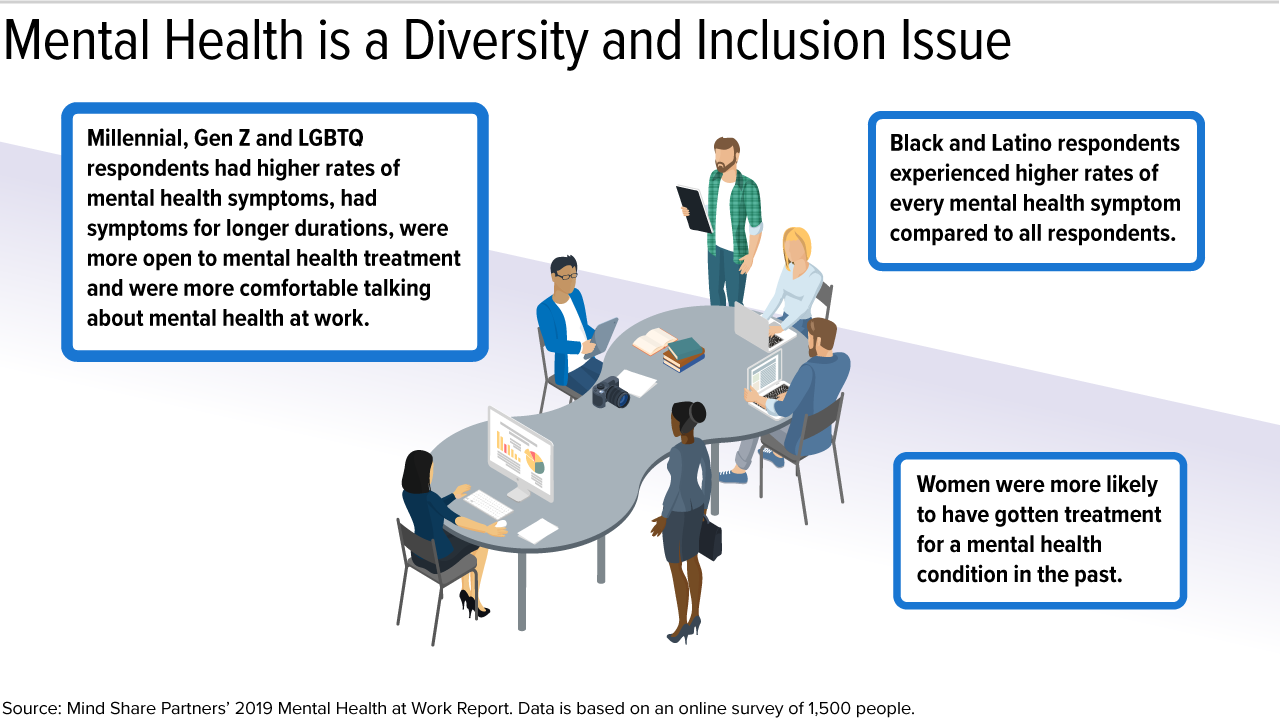Different Demographic Groups Experience Mental Health Challenges in Unique Ways
Inclusion initiatives should factor in depression, anxiety and other mental health issues

Employers should consider the distinct mental health needs of different employee groups, according to new research.
"Demographic groups experience and are impacted by mental health differently. We found significant differences across racial and ethnic groups, gender, age, sexual orientation, and parents compared to nonparents," said Mind Share Partners, a San-Francisco-based nonprofit, in its Mental Health at Work: 2019 Report.
The findings are from an online survey of 1,500 full-time U.S. workers conducted in partnership with SAP and Qualtrics.
The research found that members of Generation Z and Millennials, for example, were more likely to experience mental health symptoms for longer durations than other generations and were more open to diagnosis and treatment and talking about mental health at work.

Women were more likely to report symptoms related to eating disorders and anxiety. Men were more likely to report symptoms related to aggression. And parents were more likely than nonparents to report experiencing symptoms that are aligned with anxiety and mania.
"We found parents tend to have some level of guilt … [that] manifests with anxiety," said Mike Maughan, head of global insights at Qualtrics. "When [they] are home with their kids, then their mind is often at work and that produces anxiety" and when they are at work, they experience anxiety about not being with their child.
Workers identifying as LGBTQ were more likely to indicate they experienced all 12 mental health symptoms listed in the survey that impact productivity—such as difficulty concentrating, taking longer to do tasks and difficulty thinking, reasoning or making decisions—than those who did not identify as LGBTQ.
[Sidebar: Experiencing Negative Mental Health Symptoms? You're Not Alone]
A blog post on the National Alliance for Mental Illness (NAMI) of Massachusetts site noted that LGBT individuals struggle with family rejection and harassment; "the stress of coming out… can lead to depression, thoughts of suicide and substance abuse."
The American Psychiatric Association (APA) also has written about disparities in mental health among diverse populations. It reported, for example, that although the rate of depression is lower in people who are black or Hispanic than people who are white, depression among people who are black or Hispanic is likely to be more persistent.
But because of the stigma surrounding mental health illnesses, these conditions often go untreated, leading to lowered productivity, absenteeism and turnover. A previous NAMI report found that 62 percent of missed work days can be attributed to mental health conditions.
Addressing Mental Health Issues
There are differences in the types of services—out-patient, prescription, in-patient—that are used more frequently by people of different ethnic or racial groups. Black adults and people reporting two or more races, for example, used inpatient mental health services more frequently than other groups, according to the Substance Abuse and Mental Health Services Administration.
[SHRM members-only toolkit: Employing People with Mental Health Disabilities]
But there are barriers that prevent people from diverse ethnic or racial groups from receiving care, according to the APA:
- Lack of insurance or being underinsured.
- Lack of diversity among mental health care providers.
- Lack of culturally competent providers.
- Language barriers.
- Distrust in the health care system.
- The stigma associated with mental health problems.
In addition to educating the workplace in general, "people want their managers and HR to respond well and in an informed manner when they have these conversations," Maughan said.
Unum, in its newly released 2019 mental health report, Strong Minds at Work, suggested the following steps organizations can take to support their employees:
- Normalize the conversation. Consider naming mental health champions to encourage healthy dialogue. Involve senior leaders in this effort.
- Implement strong policies and procedures that protect employees against discrimination. This can help remove barriers that might discourage people from seeking help. Mind Share Partners, for example, found two-thirds of workers hide their mental health condition from colleagues because they fear being viewed negatively, and 95 percent of workers who took time off because of stress gave a more palatable reason—such as a headache or upset stomach—for calling in sick.
- Establish a workplace mental wellness program to create a supportive workplace. Anxiety, mood and attention-deficit/hyperactivity disorder are the most common mental health ailments in the workplace, according to Unum. It suggested offering wellness sessions or work/life balance programs and bringing in an expert to talk about topics such as recognizing signs of distress in others.
"Creating a workplace culture that promotes mental health resources and encourages employees to take advantage of them helps to destigmatize mental health issues and leads to a happier, more productive workforce."
Advertisement
An organization run by AI is not a futuristic concept. Such technology is already a part of many workplaces and will continue to shape the labor market and HR. Here's how employers and employees can successfully manage generative AI and other AI-powered systems.
Advertisement


